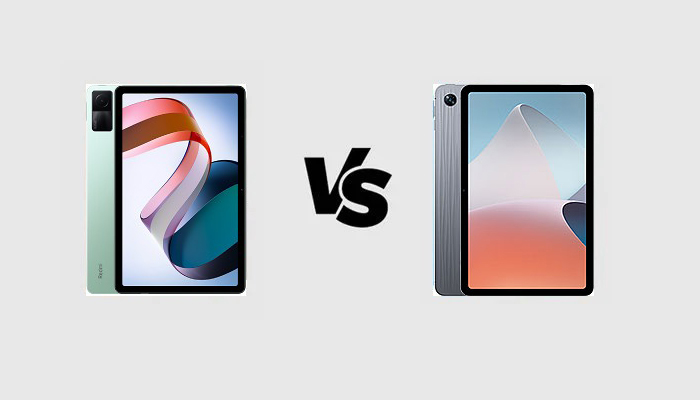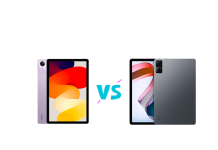Earlier this month, main Xiaomi’s sub-brand released its first tablet ever: the Redmi Pad. As a lot of people expected, it is an affordable tablet. But it is not a low-end device: you can consider it a good mid-ranger. So, it is positioned in the most competitive segment of the tablet market. In this segment, it has several rivals and among the latest ones, there is OPPO Pad Air. While the Redmi Pad is Redmi’s first tablet, this device is the second OPPO tablet but also the first to hit the global market. And they belong to the same price range. So which one should you choose in order to get the highest value for money? This is a comparison between the main specifications of the Redmi Pad and the OPPO Pad Air which will hopefully let you find out.

Xiaomi Redmi Pad vs OPPO Pad Air
| Xiaomi Redmi Pad | OPPO Pad Air | |
|---|---|---|
| DIMENSIONS AND WEIGHT | 250.5 x 158.1 x 7.1 mm, 465 grams | 245.1 x 154.8 x 6.9 mm, 440 g |
| DISPLAY | 10.61 inches, 1200 x 2000p (Full HD+), IPS LCD | 10.36 inches, 1200 x 2000p (Full HD+), IPS LCD |
| PROCESSOR | MediaTek Helio G99, octa-core 2.2 GHz | Qualcomm Snapdragon 680, octa-core 2.4 GHz |
| MEMORY | 3 GB RAM, 64 GB – 4 GB RAM, 128 GB – 6 GB RAM, 128 GB – micro SD slot | 4 GB RAM, 64 GB – 4 GB RAM, 128 GB – 6 GB RAM, 128 GB – micro SD slot |
| SOFTWARE | Android 12, MIUI | Android 12, ColorOS |
| CONNECTIVITY | Wi-Fi 802.11 a/b/g/n/ac, Bluetooth 5.2, GPS | Wi-Fi 802.11 a/b/g/n/ac, Bluetooth 5.1, GPS |
| CAMERA | Single 8 MP f/2.0 8 MP f/2.3 front camera |
Single 8 MP f/2.0 5 MP f/2.2 front camera |
| BATTERY | 8000 mAh, fast charging 18W | 7100 mAh, fast charging 18W |
| ADDITIONAL FEATURES | Ultrawide front camera | Stylus support |
Design
Having a beautiful and compact tablet is very important for those who want to bring it everywhere and show it to their friends or at work. Of these two tablets, the OPPO Pad Air is definitely the most beautiful one. Not only that: it is one of the most beautiful tablets you can find in the whole market. It comes with a very thin body: the thickness is just 6.9 mm. The bezels around the display are very narrow and the rear cover is made of two different textures and which is very attractive. The Redmi Pad is definitely uglier, even though it is built with an aluminum frame. It is still a thin tablet, but it is bigger and it has thicker bezels around the display. There is no way for it to compete with OPPO. Unfortunately, these tablets can only be unlocked with a password and they do not feature biometric sensors.
Display
The displays of these two devices are very close to each other in terms of image quality. indeed, the most important differences between them are the size and the refresh rate. The Redmi Pad has a bigger panel with a diagonal of 10.61 inches instead of just 10.36 inches. Further, it has a high 90 Hz refresh rate instead of just 60 Hz, so you can have a smoother experience during gaming sessions and while browsing the user interface. These displays are IPS LCD panels, so do not expect amazing color reproduction. But they are still very nice because they are able to show one billion colors. They also provide a good level of detail thanks to a resolution of 1200 x 2000 pixels. Even the brightness is not bad with 360 or 400 nits. These tablets feature stereo speakers so that you can have a great audio experience. But, unfortunately, they do not come with a 3.5 mm audio jack.
Specs & Software
These tablets are both mid-rangers, but they are powered by different chipsets. And if you are looking for the best performance, then the Redmi Pad by Xiaomi should be your choice. It is the world’s first tablet with the Helio G99 mobile platform by MediaTek. It is a midrange chipset built with a 6 nm production process and sporting an octa-core architecture composed of two Cortex A76 CPUs running at a max frequency of 2.2 GHz, six Cortex A55 CPUs running at a max frequency of 2 GHz, and a Mali G57 MC2 GPU. Alongside this processor, there are up to 6 GB of RAM and up to 128 GB of UFS 2.2 internal storage. The OPPO Pad Air is powered by the Snapdragon 680 chipset built with a 6 nm production process and with an octa-core architecture composed of four Kryo 265 Gold CPUs running at a max frequency of 2.4 GHz, four Kryo 265 Silver CPUs running at 1.9 GHz, and an Adreno 610 GPU. The highest-end memory configuration of this device is the same, with up to 6 GB of RAM and up to 128 GB of native storage. The Helio G99 chipset is superior to the Snapdragon 680. These two tablets run Android 12 out of the box with highly customized user interfaces on top, and the OPPO has special features designed for tablets.
Camera
While the main cameras of these tablets are the same 8 MP sensors and provide similar photo quality, the Redmi Pad is equipped with a better front camera, sporting an 8 MP resolution and an ultrawide lens with a FOV of up to 105 degrees.
Battery
The Redmi Pad is able to provide a longer battery life thanks to the presence of a bigger 8000 mAh, while the charging speeds are the same.
Price
The Redmi Pad carries a starting price of €250 or $250 in China, while the OPPO Pad Air starts from €300 or $300. Now that you know all the differences, which one would you pick?
Xiaomi Redmi Pad vs OPPO Pad Air: PRO and CONS
Xiaomi Redmi Pad
PRO
- Bigger battery
- Wider display
- Better front camera
- Better chipset
CONS
- Limited availability
OPPO Pad Air
PRO
- Worldwide availability
- ColorOS for Pad
- Stylus support
- Better design
CONS
- Inferior chipset
- Smaller battery
RELATED






